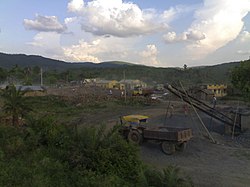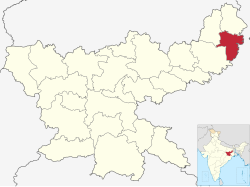Pakur district is one of the twenty-four districts of Jharkhand state, India, and Pakur is the administrative headquarters of this district. Pakur sub-division of Sahibganj district was carved out on 28 January 1994 to constitute Pakur District. The district, with a population of 900,422 (census 2011), and covering an area of 686.21 km2, is situated on the north-eastern corner of Jharkhand state.
Pakur district | |
|---|---|
 A stone-quarrying unit in Pakur district | |
 Location of Pakur district in Jharkhand | |
| Country | |
| State | |
| Division | Santhal Pargana |
| Headquarters | Pakur |
| Government | |
| • Deputy Commissioner | Shri. Manish Kumar (IAS) |
| • Lok Sabha constituencies | Rajmahal (shared with Sahebganj district) |
| • Vidhan Sabha constituencies | 3 |
| Area | |
| • Total | 1,805.59 km2 (697.14 sq mi) |
| Population (2011)[1] | |
| • Total | 900,422 |
| • Density | 500/km2 (1,300/sq mi) |
| • Urban | 5.13% |
| Demographics | |
| • Literacy | 48.82 per cent |
| • Sex ratio | 989 |
| Time zone | UTC+05:30 (IST) |
| Website | pakur |
Geography
editThe district is bounded on the north by Sahibganj district, on the south by Dumka district, on the west by Godda district, and on the east by Birbhum and Murshidabad districts of West Bengal.[2] The west of the district contains the Rajmahal Hills, while the east of the district is mostly flat plain.
Economy
editIt is famous for its Black stone. It is generating the highest revenue for Howrah railway Division by supplying Black Stone Chips across India and Coal to Punjab.
In the past, Pakur was a land populated by Santhals and Mal Paharia people. However, over a period of time, demographic composition has gradually changed to the modern era, and the local folks have come to the mainstream of the Indian society.
In 2006 the Ministry of Panchayati Raj named Pakur one of the country's 250 most backward districts (out of a total of 640).[3] It is one of the 21 districts in Jharkhand currently receiving funds from the Backward Regions Grant Fund Programme (BRGF).[3]
Administration
editBlocks/Mandals
editPakur district consists of six community development blocks. The following are the list of the blocks in the Pakur district:
Demographics
edit| Year | Pop. | ±% p.a. |
|---|---|---|
| 1901 | 215,587 | — |
| 1911 | 224,304 | +0.40% |
| 1921 | 214,299 | −0.46% |
| 1931 | 244,945 | +1.35% |
| 1941 | 266,956 | +0.86% |
| 1951 | 277,421 | +0.39% |
| 1961 | 347,012 | +2.26% |
| 1971 | 403,078 | +1.51% |
| 1981 | 464,154 | +1.42% |
| 1991 | 564,253 | +1.97% |
| 2001 | 701,664 | +2.20% |
| 2011 | 900,422 | +2.53% |
| source:[4] | ||
According to the 2011 census Pakur district has a population of 900,422,[1] roughly equal to the nation of Fiji.[6] This gives it a ranking of 465th in India (out of a total of 640).[1] The district has a population density of 498 inhabitants per square kilometre (1,290/sq mi).[1] Its population growth rate over the decade 2001-2011 was 28.15%.[1] Pakur has a sex ratio of 985 females for every 1000 males,[1] and a literacy rate of 48.82%. 7.50% of the population lives in ruban areas. Scheduled Castes and Scheduled Tribes make up 3.16% and 42.10% of the population respectively.[1]
At the time of the 2011 Census of India, 39.42% of the population in the district spoke Bengali, 36.40% Santali, 11.84% Khortha, 4.90% Malto, 2.83% Hindi, 1.77% Urdu and 1.66% Bhojpuri as their first language.[7]
Villages
editPolitics
edit| District | No. | Constituency | Name | Party | Alliance | Remarks | ||
|---|---|---|---|---|---|---|---|---|
| Pakur | 4 | Litipara | Dinesh William Marandi | Jharkhand Mukti Morcha | Mahagathbandhan (Jharkhand) | |||
| 5 | Pakur | Alamgir Alam | Indian National Congress | Mahagathbandhan (Jharkhand) | Cabinet Minister (Parliamentary Affairs, Rural development) | |||
| 6 | Maheshpur | Stephen Marandi | Jharkhand Mukti Morcha | Mahagathbandhan (Jharkhand) | ||||
See also
editReferences
edit- ^ a b c d e f g "District Census Handbook: Pakur" (PDF). Census of India. Registrar General and Census Commissioner of India.
- ^ "Profile". Archived from the original on 12 July 2014. Retrieved 10 May 2012.
- ^ a b Ministry of Panchayati Raj (8 September 2009). "A Note on the Backward Regions Grant Fund Programme" (PDF). National Institute of Rural Development. Archived from the original (PDF) on 5 April 2012. Retrieved 27 September 2011.
- ^ "Table A-02 Decadal Variation in Population Since 1901: Jharkhand" (PDF). census.gov.in. Registrar General and Census Commissioner of India.
- ^ "Table C-01 Population By Religion: Jharkhand". census.gov.in. Registrar General and Census Commissioner of India.
- ^ US Directorate of Intelligence. "Country Comparison:Population". Archived from the original on 13 June 2007. Retrieved 1 October 2011.
Fiji 883,125 July 2011 est.
- ^ a b "Table C-16 Population by Mother Tongue: Jharkhand". censusindia.gov.in. Registrar General and Census Commissioner of India.